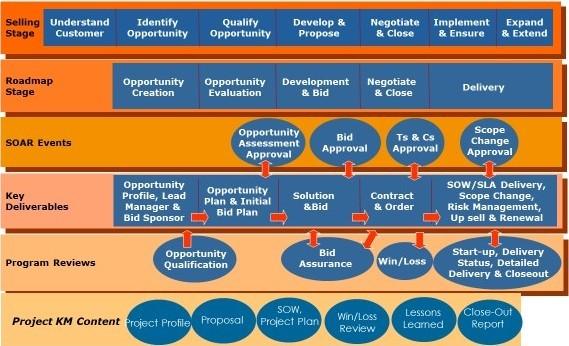KM Component 23 – Workflow Process

Stan Garfield
Workflow is embedding knowledge creation, capture, and reuse in business processes so that these steps happen routinely as part of normal work.
Individuals do not get excited about their organization’s attempts to manage knowledge and are skeptical about the possibility of doing so. But when they need to know something in order to do their jobs, they want to be able to access the information immediately. This can cause problems because people want to find reusable content, but they don’t want to spend any extra time contributing it. One way to address this imbalance is to embed knowledge capture into normal work processes.
The Workflow Management Coalition defines workflow as the “automation of a business process, in whole or part, during which documents, information or tasks are passed from one participant to another for action, according to a set of procedural rules.” Workflow automation applies to more than just knowledge management, but it can be used as part of a KM initiative to add knowledge flow to routine business processes.
For example, when new customer orders are entered in a company’s business management system, it should be possible to extract customer information from that system for use in a knowledge repository. Users should not have to reenter basic information such as customer name, industry, location, and order amount – these should be passed along from the business system to the KM tool.
A project management system can be used to prompt project managers to enter lessons learned reports, project summaries, and other reusable documents at appropriate times. A Customer Relationship Management (CRM) system can be used to find details about customer references. The employee expense reporting system can be used to enforce the capture of required content by not authorizing reimbursement payments until that content has been submitted.
Clever use of workflow can enable knowledge to be presented at opportune times for applying it. For example, a sales representative enters a request for presales support into a system and is provided with links to web sites and documents relevant to the requested topic. Later, once the sale has been closed, the rep enters a request for commission payment into another system and is prompted to enter data into a form which captures lessons learned about the deal.
As much as possible, avoid the need for users to visit a separate KM system and instead, allow them to use other business systems to create, capture, and reuse knowledge. If you can make these processes as transparent as possible to your users, you will simplify their tasks and increase their satisfaction with the environment.
Workflow Example
Here is an example of project management workflow at HP. It shows the stages of the project lifecycle, the events and reviews that take place, and the deliverables and knowledge management content that are expected to be captured at each stage.

Additional Resources
For more about workflow, see this content from Lucidea:
Blog Posts
- Evaluating Archival Workflows and Programs
- Optimizing Workflows and Reporting Capabilities with Your CMS
- Museum CMS 101: Workflow and Record Construction
Webinar Recording

Stan Garfield
Please enjoy Stan’s additional blog postsoffering advice and insights drawn from many years as a KM practitioner. You may also want to download a copy of his book, Proven Practices for Implementing a Knowledge Management Program, from Lucidea Press. And learn about Lucidea’s Inmagic Presto and SydneyEnterprise with KM capabilities to support successful knowledge curation and sharing.
Similar Posts
Lucidea’s Lens: Knowledge Management Thought Leaders
Part 110 – Tom Stewart
In this Lucidea’s Lens profile Stan Garfield spotlights Tom Stewart—strategist author and former HBR editor—whose groundbreaking thinking redefined intellectual capital.
Lucidea’s Lens: Knowledge Management Thought Leaders
Part 109 – Dave Snowden
Dave Snowden Founder of The Cynefin Company applies complexity science anthropology and narrative to help organizations make sense of uncertainty and change.
Lucidea’s Lens: Knowledge Management Thought Leaders
Part 108 – George Siemens
In this edition of Lucidea’s Lens Stan Garfield profiles George Siemens—pioneering voice in connectivism and a driving force behind MOOCs and learning analytics—whose work continues to reshape how we understand learning knowledge creation and the role of technology in education and professional development.
Lucidea’s Lens: Knowledge Management Thought Leaders
Part 107 – Arthur Shelley
Explore Arthur Shelley’s insights on leadership co-creation and knowledge strategy through curated works that showcase his expertise in collaboration and innovation.






Leave a Comment
Comments are reviewed and must adhere to our comments policy.
0 Comments